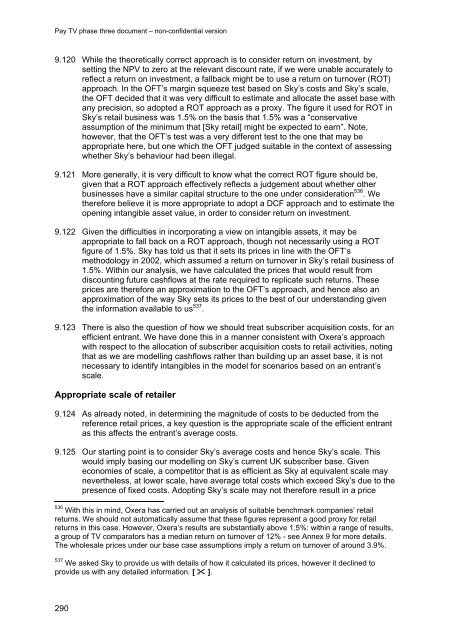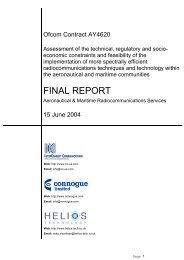Pay TV phase three document - Stakeholders - Ofcom
Pay TV phase three document - Stakeholders - Ofcom
Pay TV phase three document - Stakeholders - Ofcom
Create successful ePaper yourself
Turn your PDF publications into a flip-book with our unique Google optimized e-Paper software.
<strong>Pay</strong> <strong>TV</strong> <strong>phase</strong> <strong>three</strong> <strong>document</strong> – non-confidential version<br />
9.120 While the theoretically correct approach is to consider return on investment, by<br />
setting the NPV to zero at the relevant discount rate, if we were unable accurately to<br />
reflect a return on investment, a fallback might be to use a return on turnover (ROT)<br />
approach. In the OFT’s margin squeeze test based on Sky’s costs and Sky’s scale,<br />
the OFT decided that it was very difficult to estimate and allocate the asset base with<br />
any precision, so adopted a ROT approach as a proxy. The figure it used for ROT in<br />
Sky’s retail business was 1.5% on the basis that 1.5% was a “conservative<br />
assumption of the minimum that [Sky retail] might be expected to earn”. Note,<br />
however, that the OFT’s test was a very different test to the one that may be<br />
appropriate here, but one which the OFT judged suitable in the context of assessing<br />
whether Sky’s behaviour had been illegal.<br />
9.121 More generally, it is very difficult to know what the correct ROT figure should be,<br />
given that a ROT approach effectively reflects a judgement about whether other<br />
businesses have a similar capital structure to the one under consideration 536 . We<br />
therefore believe it is more appropriate to adopt a DCF approach and to estimate the<br />
opening intangible asset value, in order to consider return on investment.<br />
9.122 Given the difficulties in incorporating a view on intangible assets, it may be<br />
appropriate to fall back on a ROT approach, though not necessarily using a ROT<br />
figure of 1.5%. Sky has told us that it sets its prices in line with the OFT’s<br />
methodology in 2002, which assumed a return on turnover in Sky’s retail business of<br />
1.5%. Within our analysis, we have calculated the prices that would result from<br />
discounting future cashflows at the rate required to replicate such returns. These<br />
prices are therefore an approximation to the OFT’s approach, and hence also an<br />
approximation of the way Sky sets its prices to the best of our understanding given<br />
the information available to us 537 .<br />
9.123 There is also the question of how we should treat subscriber acquisition costs, for an<br />
efficient entrant. We have done this in a manner consistent with Oxera’s approach<br />
with respect to the allocation of subscriber acquisition costs to retail activities, noting<br />
that as we are modelling cashflows rather than building up an asset base, it is not<br />
necessary to identify intangibles in the model for scenarios based on an entrant’s<br />
scale.<br />
Appropriate scale of retailer<br />
9.124 As already noted, in determining the magnitude of costs to be deducted from the<br />
reference retail prices, a key question is the appropriate scale of the efficient entrant<br />
as this affects the entrant’s average costs.<br />
9.125 Our starting point is to consider Sky’s average costs and hence Sky’s scale. This<br />
would imply basing our modelling on Sky’s current UK subscriber base. Given<br />
economies of scale, a competitor that is as efficient as Sky at equivalent scale may<br />
nevertheless, at lower scale, have average total costs which exceed Sky’s due to the<br />
presence of fixed costs. Adopting Sky’s scale may not therefore result in a price<br />
536 With this in mind, Oxera has carried out an analysis of suitable benchmark companies’ retail<br />
returns. We should not automatically assume that these figures represent a good proxy for retail<br />
returns in this case. However, Oxera’s results are substantially above 1.5%: within a range of results,<br />
a group of <strong>TV</strong> comparators has a median return on turnover of 12% - see Annex 9 for more details.<br />
The wholesale prices under our base case assumptions imply a return on turnover of around 3.9%.<br />
537 We asked Sky to provide us with details of how it calculated its prices, however it declined to<br />
provide us with any detailed information. [ � ].<br />
290
















